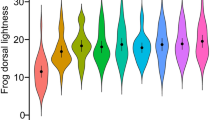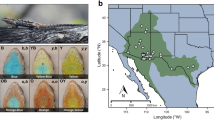Abstract
Some crepuscular and nocturnal animals are brightly marked yet the adaptive significance of their colorful patterns in low light, as found at twilight and night, is poorly understood. This phenomenon is particular prevalent in amphibians. Of the nearly 80% of nocturnal frogs, many exhibit color patterns with red, yellow, green and blue hues and/or contrasting spots and stripes. Despite the prevalence of these conspicuous visual signals in frogs, the function and adaptive significance of bright coloration for crepuscular/nocturnal frogs is still poorly understood. A critical first step in linking color pattern evolution with premating reproductive isolation and lineage divergence is determining whether color pattern plays a role in mate recognition in dim light. We studied the brightly colored Red-eyed Treefrog (Agalychnis callidryas), a crepuscular/nocturnal Neotropical treefrog that exhibits noteworthy geographic variation in color pattern and female choice for local male phenotypes. We measured retinal photoreceptor cell absorbance via microspectrophotometry and used visual modeling to assess whether distinct color pattern phenotypes were distinguishable as luminosity and chromaticity cues. We found that the Red-eyed Treefrog visual system is capable of discriminating differences in color patterns as brightness (luminosity) in their perception of nighttime visual cues. Differences in color (chromaticity) were also detectable in dim light, although less prominent than brightness. Combined, our data indicate that differences in these visual traits are discernable, can function for species and population recognition, and evolve through sexual selection. These social signals are thus analogous to the widespread visual displays exhibited by diurnal vertebrates, suggesting that the richness of similar sensory interactions among animals at twilight and after dark might be severely underappreciated. More generally, we demonstrate that combining studies of the visual system with population genetics, behavior, and natural history provides a framework for testing the evolution and adaptive function of color pattern.




Similar content being viewed by others
Data availability
MSP data available at Dryad. https://doi.org/10.5061/dryad.kkwh70s5n
Code availability
Code for pavo analyses, and moonlight illuminant data available at Dryad.https://doi.org/10.5061/dryad.kkwh70s5n R
References
Akopyan M, Kaiser K, Savant NG, Owen CY, Vega A, Dudgeon SR, Robertson JM (2017) Melodic males and flashy females: geographic variation in male and female reproductive behavior in red-eyed treefrogs (Agalychnis callidryas). Ethology. https://doi.org/10.1111/eth.12705
Akopyan M, Gompert Z, Klonoski K, Vega A, Kaiser K, Mackelprang R, Rosenblum EB, Robertson JM (2020) Genetic and phenotypic evidence of a contact zone between divergent colour morphs of the iconic red-eyed treefrog. Mol Ecol. 29(22):4442–4456. https://doi.org/10.1111/mec.15639
Aviles JM, Parejo D (2012) Covariation between bill colouration and fitness components in a nocturnal bird. J Avian Biol. 43(6):565–570. https://doi.org/10.1111/j.1600-048X.2012.05819.x
Boul KE, Funk WC, Darst CR, Cannatella DC, Ryan MJ (2007) Sexual selection drives speciation in an Amazonian frog. Proc Roy Soc B 274(1608):399–406
Cummings ME, Bernal XE, Reynaga R, Rand AS, Ryan MJ (2008) Visual sensitivity to a conspicuous male cue varies by reproductive state in Physalaemus pustulosus females. J Exp Biol 211(8):1203–1210. https://doi.org/10.1242/jeb.012963
Donner K, Yovanovich CAM (2020) A frog’s eye view: foundational revelations and future promises. Semin Cell Dev Biol. https://doi.org/10.1016/j.semcdb.2020.05.011
Duellman W (1970) The hylid frogs of Middle America. University of Kansas, Lawrence
Endler JA, Westcott DA, Madden JR, Robson T (2005) Animal visual systems and the evolution of color patterns: sensory processing illuminates signal evolution. Evolution 59(8):1795–1818
Fleishman LJ, Bowman M, Saunders D, Miller WE, Rury MJ, Loew ER (1997) The visual ecology of Puerto Rican anoline lizards: habitat light and spectral sensitivity. J Comp Physiol A 181(5):446–460
Gomez D, Richardson C, Lengagne T, Plenet S, Joly P, Lena J-P, Thery M (2009) The role of nocturnal vision in mate choice: females prefer conspicuous males in the European tree frog (Hyla arborea). Proc R Soc 276(1666):2351–2358. https://doi.org/10.1098/rspb.2009.0168
Govardovskii VI, Fyhrquist N, Reuter T, Kuzmin DG, Donner K (2000) In search of the visual pigment template. Vis Neurosc 17(4):509–528. https://doi.org/10.1017/S0952523800174036
Hartmann MT, Giasson LOM, Hartmann PA, Haddad CFB (2005) Visual communication in Brazilian species of anurans from the Atlantic forest. J Nat Hist 39(19):1675–1685. https://doi.org/10.1080/00222930400008744
Hill GE, Hill GE, McGraw KJ, McGraw KJ (2006) Bird Coloration: function and evolution. Harvard University Press, Cambridge
Hoffman EA, Blouin MS (2000) A review of colour and pattern polymorphisms in anurans. Biol J Linn Soc Lond 70(4):633–665
Jacobs L, Vega A, Dudgeon S, Kaiser K, Robertson JM (2016) Local not vocal: assortative female choice in divergent populations of red-eyed treefrogs, Agalychnis callidryas (Hylidae: Phyllomedusinae). Biol J Linn Soc Lond. https://doi.org/10.1111/bij.12861
Kaiser K, Boehlke C, Navarro-Perez E, Vega A, Dudgeon S, Robertson JM (2018) Local preference encoded by complex signaling: mechanisms of mate preference in the red-eyed treefrog (Agalychnis callidryas). Behav Ecol Sociobiol. https://doi.org/10.1007/s00265-018-2597-0
Kelber A, Roth LSV (2006) Nocturnal colour vision—not as rare as we might think. J Exp Biol 209(5):781–788. https://doi.org/10.1242/jeb.02060
Kelber A, Balkenius A, Warrant EJ (2002) Scotopic colour vision in nocturnal hawkmoths. Nature 419(6910):922–925. https://doi.org/10.1038/nature01065
Kelber A, Vorobyev M, Osorio D (2003) Animal colour vision—behavioural tests and physiological concepts. Biol Rev 78(1):81–118. https://doi.org/10.1017/s1464793102005985
Liebau A, Eisenberg T, Esser KH (2015) The scotopic and photopic visual sensitivity in the nocturnal tree frog Agalychnis callidryas. J Comp Physiol A Neuroethol Sens Neural Behav Physiol 201(10):1035–1041. https://doi.org/10.1007/s00359-015-1028-1
Loew ER (1994) A third, ultraviolet-sensitive, visual pigment in the Tokay Gecko (Gekko gekko). Vis Res 34(11):1427–1431
Losos JB (1985) An experimental demonstration of the species recognition role of Anolis dewlap color. Copeia 1985(4):905–910
Lythgoe JN, Partridge JC (1991) The modelling of optimal visual pigments of dichromatic teleosts in green coastal waters. Vis Res 31(3):361–371
Maan ME, Cummings ME (2008) Female preferences for aposematic signal components in a polymorphic poison frog. Evolution 62(9):2334–2345. https://doi.org/10.1111/j.1558-5646.2008.00454.x
MacNichol EF (1986) A unifying presentation of photopigment spectra. Vis Res 26(9):1543–1556. https://doi.org/10.1016/0042-6989(86)90174-4
Maia R, Gruson H, Endler JA, White TE (2019) Pavo 2: new tools for the spectral and spatial analysis of colour in r. Methods Ecol Evol 10(7):1097–1107. https://doi.org/10.1111/2041-210X.13174
Masta SE, Maddison WP (2002) Sexual selection driving diversification in jumping spiders. Proc Natl Acad Sci USA 99(7):4442–4447
Mohun S, Davies W (2019) The evolution of amphibian photoreception. Front Ecol Evol. https://doi.org/10.3389/fevo.2019.00321
Muntz WRA (1964) The development of photopic and scotopic vision in the frog (Rana temporaria). Vis Res 4(3–4):241–250
Muntz WRA (1977) The visual system in vertebrates. Springer-Verlag, Berlin
Olsson P, Lind O, Kelber A (2018) Chromatic and achromatic vision: parameter choice and limitations for reliable model predictions. Behav Ecol 29(2):273–282. https://doi.org/10.1093/beheco/arx133
Panhuis TM, Butlin R, Zuk M, Tregenza T (2001) Sexual selection and speciation. Trends Ecol Evol 16(7):364–371
Penteriani V, Delgado M (2017) Living in the dark does not mean a blind life: bird and mammal visual communication in dim light. Phil Trans R Soc B. https://doi.org/10.1098/rstb.2016.0064
Pyburn WF (1964) Breeding behavior of the leaf-frog, Phyllomedusa callidryas, in southern Veracruz. Yearb Am Philos Soc. 1964:291–294
Pyburn WF (1970) Breeding behavior of leaf-frogs Phyllomedusa callidryas and Phyllomedusa dacnicolor in Mexico. Copeia. https://doi.org/10.2307/1441643
Robertson JM, Greene HW (2017) Bright colour patterns as social signals in nocturnal frogs. Biol J Linnean Soc 121(4):849–857. https://doi.org/10.1093/biolinnean/blx021
Robertson J, Robertson A (2008) Spatial and temporal patterns of phenotypic variation in a Neotropical frog. J Biogeogr 35(5):830–843
Robertson JM, Vega A (2011) Genetic and phenotypic variation in a colourful treefrog across five geographic barriers. J Biogeogr 38(11):2122–2135
Robertson JM, Zamudio KR (2009) Genetic diversification, vicariance, and selection in a polytypic frog. J Hered 100(6):715–731. https://doi.org/10.1093/jhered/esp041
Robertson JM, Duryea MC, Zamudio KR (2009) Discordant patterns of evolutionary differentiation in two Neotropical treefrogs. Mol Ecol 18(7):1375–1395. https://doi.org/10.1111/j.1365-294X.2009.04126.x
Rosenthal GG, Rand AS, Ryan MJ (2004) The vocal sac as a visual cue in anuran communication: an experimental analysis using video playback. Anim Behav. https://doi.org/10.1016/j.anbehav.2003.07.013
Ryan MJ (2001) Anuran Communication. Smithsonian Institution Press, Washington
Ryan MJ, Rand AS (1993) Species recognition and sexual xelection as a unitary problem in animal communication. Evolution 47(2):647–657
Santiago C, Green NF, Hamilton N, Endler JA, Osorio DC, Marshall NJ, Cheney KL (2020) Does conspicuousness scale linearly with colour distance? A test using reef fish. Proc Biol Sci. https://doi.org/10.1098/rspb.2020.1456
Savage JM (2002) The amphibians and reptiles of costa rica: a herpetofauna between two continents, between two seas. University of Chicago Press, Chicago
Schwalm PA, Starrett PH, McDiarmid RW (1977) Infrared reflectance in leaf-sitting Neotropical frogs. Science 196(4295):1225–1227
Seehausen O, Terai Y, Magalhaes IS, Carleton KL, Mrosso HDJ, Miyagi R, van der Sluijs I, Schneider MV, Maan ME, Tachida H, Imai H, Okada N (2008) Speciation through sensory drive in cichlid fish. Nature 455(7213):620-U623. https://doi.org/10.1038/nature07285
Sztatecsny M, Strondl C, Baierl A, Ries C, Hodl W (2010) Chin up: are the bright throats of male common frogs a condition-independent visual cue? Anim Behav 79(4):779–786. https://doi.org/10.1016/j.anbehav.2010.01.003
Taylor R, Buchanan B, Doherty J (2007) Sexual selection in the squirrel treefrog Hyla squirella: the role of multimodal cue assessment in female choice. Anim Behav. https://doi.org/10.1016/j.anbehav.2007.03.010
Vorobyev M, Osorio D, Bennett ATD, Marshall NJ, Cuthill IC (1998) Tetrachromacy, oil droplets and bird plumage colours. J Comp Physiol 183(5):621–633. https://doi.org/10.1007/s003590050286
Wells KD (1977) Social behavior of Anuran amphibians. Anim Behav 25:666–693
Yovanovich CAM, Koskela SM, Nevala N, Kondrashev SL, Kelber A, Donner K (2017) The dual rod system of amphibians supports colour discrimination at the absolute visual threshold. Philos Trans R Soc B-Biol Sci. https://doi.org/10.1098/rstb.2016.0066
Acknowledgements
We thank A Vega for field assistance and valuable contributions to the system; RE Espinoza, WC Funk, HW Greene, L Harmon, KI Hoke, KR Lips, E Losos, EB Rosenblum, and KR Zamudio for discussion and constructive feedback on the manuscript; and T White for advice on running analyses in pavo. This work was supported by grants from the Organization for Tropical Studies, Smithsonian Tropical Research Institute, Tinker Foundation, Einaudi Center, Department of Ecology and Evolutionary Biology at Cornell University, and NSF (Doctoral Dissertation Enhancement Grant, DEB-0506043) to JMR. We thank the Ministry of the Environment and Energy in Costa Rica (MINAE—permit no.067-2003-FAU) for permission to conduct research and export samples. Two anonymous reviewers provided helpful suggestions that improved this manuscript.
Funding
Organization for Tropical Studies, Smithsonian Tropical Research Institute, Tinker Foundation, Einaudi Center, Department of Ecology and Evolutionary Biology at Cornell University, National Science Foundation Doctoral Dissertation Enhancement Grant, DEB-0506043.
Author information
Authors and Affiliations
Corresponding author
Ethics declarations
Conflicts of interest
None.
Ethics approval
All methods were approved by the IACUC at Cornell University, protocols 2017–0043 (Loew) and 2003–0049 (Robertson). IACUC reviews and approves research in compliance with federal laws, regulations, and policies.
Consent to participate
None.
Consent for publication
We consent the publication of this work.
Additional information
Publisher's Note
Springer Nature remains neutral with regard to jurisdictional claims in published maps and institutional affiliations.
Supplementary Information
Below is the link to the electronic supplementary material.
Rights and permissions
About this article
Cite this article
Robertson, J.M., Bell, R.C. & Loew, E.R. Vision in dim light and the evolution of color pattern in a crepuscular/nocturnal frog. Evol Ecol 36, 355–371 (2022). https://doi.org/10.1007/s10682-022-10173-w
Received:
Accepted:
Published:
Issue Date:
DOI: https://doi.org/10.1007/s10682-022-10173-w




